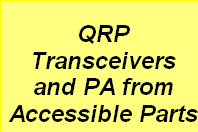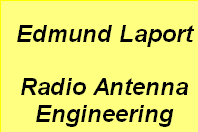

Antentop is FREE e-magazine devoted to Antennas and Amateur Radio an
Special page devoted to
Long
Delay Echoes

Custom Search
|
ANTENTOP-
01- 2007, # 009 |
Long
Delay Echoes |
|
|
|
||
|
Because our transmitters were located a couple of miles
away, we ran the receivers at full RF gain all of the time.
There was NO muting! All four receivers were wired to a
speaker panel. That meant any signal heard would be heard
throughout the building. Twice each hour, on the hour and
on the half hour, one of us (there were usually only two on duty)
would actually sit down at the receivers for "close monitor."
For that, we switched the speakers to a panel down near the desktop,
and we would sit for two minutes and monitor. At all other
times, the operator was away from the position and doing other
things, so he had to be able to hear the R388s above all the Teletype
noise in the building - and we had a When our transmitters keyed, the AGC action of the
receivers served to mute them, as we kept the AGC slow.
The first "beep" of the CW shut down the AGC, which
prevented any full breakin. There was no other muting. Just pretty
much receiver overload! Now the scene is set. It is not close monitor
time, and I, with my partner, am doing other work in the RTTY
section. We grow accustomed to hearing the receivers go
dead as our own transmitters overload them. Then the background
noise returns. Suddenly we hear: For an instant I thought it was someone calling us.
Since that did not happen unless there was a problem, I moved
quickly to the console. I stopped our automatic keying and
I listened. No one on any of the frequencies. I sent
"QRZ DE AAA123 K" with the hand key. Got no response.
I tried that maybe three times. No one was out there.
Of course I was keying all four transmitters simultaneously, so
no matter what frequency he had called in on, I would hear him.
Then it dawned on me! I had heard "DE AAA123!"
He had been identifying as my station! Not AAA123 DE AAB321,
for example. It was " |
By sheer luck, we had been running a slow speed monitor
tape on another receiver in a different rack. That was a
rack with two Collins 51S1 receivers, that we used
to monitor other things, but it had been set up to monitor a couple
of frequencies, and I had, earlier in the afternoon, set one of
those two receivers on one of our guard frequencies. The
other was on some other frequency. What if, I thought, the echo had been on that particular
guard channel? I had no way of knowing which of the console
receivers had picked up the signal but it was early evening, and
we had been about to close down the 13 mhz
guard, as it was no good for us at night, so it wasn't likely
it would be there. I could be on our 4, 6 or 10 mhz
frequencies, and there was no way of knowing. But the 51S1
was on the 6 meg guard frequency. What if! I ran the tape back. Yes, indeedy,
it had been on the 6 mhz guard frequency.
And I had a tape of it. Not only that, because because
the four channel recorder used one of its channels to permanently
monitor a highly accurate 1 KHZ oscillator, I could now tell precisely
what time the signal had been recorded, using our test gear designed
for that purpose. All that told me nothing. Except it was not one
of our field stations. It was not our own transmitter being
keyed by our keyer. It was a received
signal, and in ham language would have been RST589. We gave
it a QRK5, QSA5. The only thing I knew for sure about it
now was it had been on our 6 MHZ frequency, not on the four or
10 mhz one. I made a copy of that segment of the tape, as it was
something we wanted our technical staff to analyze for us.
They did, and learned nothing more. I kept the tape for
a few years but finally erased it. Shortly after the actual occurance,
(perhaps a few months) which neither my coworker
or I understood at the time, I happened across a story
on LDEs. And then we knew what we had heard. Again
I played the tape several times, but garnered no information from
it. Except one thing. The "echo" had begun
16 seconds after the end of our transmission. But it had
not begun at the beginning. It had not echo'ed
our entire transmission, only a few seconds of it. All this took place outside the |
|
|
|
||
|
Page 66 |
||
 |
 |
 |
 |
Just for Fun:

Powered byIP2Location.com
Thanks for your time!
Last Updated:
February 11, 2018 17:35




